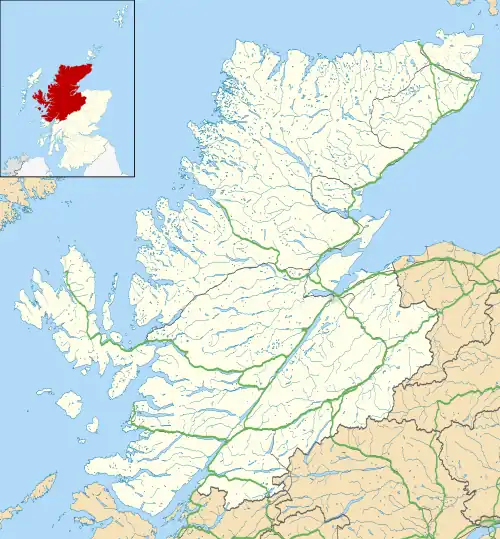| Nairn Town and County Buildings | |
|---|---|
.jpg.webp) Nairn Town and County Buildings | |
| Location | High Street, Nairn |
| Coordinates | 57°35′06″N 3°52′07″W / 57.5850°N 3.8686°W |
| Built | 1818 |
| Architect | Mr Smith |
| Architectural style(s) | Neoclassical style |
Listed Building – Category B | |
| Official name | Former Court House including prison and boundary walls to rear, High Street, Nairn |
| Designated | 12 March 1981 |
| Reference no. | LB38427 |
 Shown in Highland | |
Nairn Town and County Buildings is a municipal structure in the High Street, Nairn, Highland, Scotland. The structure, which is used as a service point for The Highland Council, is a Category B listed building.[1]
History
The first municipal building in Nairn was an old tolbooth which was built on land donated by Hugh Rose of Kilravock Castle[2] in the late 16th century.[3] The covenanter, Thomas Ross, after being accused of keeping conventicles, was imprisoned in the tolbooth in 1675.[4] The building was destroyed by Royalist troops in 1716 and rebuilt in the mid-18th century.[3] After the tolbooth became dilapidated in the early 19th century, the burgh leaders decided to demolish it and to replace it with a new building.[3]
The new building was designed by a Mr Smith, built by a local mason, John Wilson, in ashlar stone at a cost of £1,392 and was completed in 1818.[5] The original design involved a symmetrical main frontage with five bays facing onto the High Street; the central bay, which slightly projected forward, featured a doorway on the ground floor, a mullioned window on the first floor and a square castellated tower above. The tower featured a niche flanked by lancet windows at the front and was surmounted by an octagonal belfry and by a spire. There was regular fenestration in the outer bays.[6]
A new bell, cast by Thomas Mears of London, was installed in the belfry, replacing two smaller bells, in 1843.[5] A prison, erected at the rear of the building to a design by Thomas Brown, was completed in 1844, and further work, which included the replacement of the belfry and spire with a more elaborate structure incorporating clock faces, was carried out to a design by Alexander and William Reid in 1870.[1][7][8] The new spire was 24.7 metres (81 ft) high.[5] Internally, the principal rooms included a council chamber, for meetings of the burgh council, and a courtroom, for magistrates' and sheriffs' court hearings, and there was an archive room in the tower.[9][10]
Following the implementation of the Local Government (Scotland) Act 1889 which established a uniform system of county councils in Scotland, the new Nairn County Council also established its offices in the building: however, the county council amalgamated with Moray County Council, forming a new joint administration at offices in Elgin in 1930.[11]
The building continued to serve as the meeting place of the enlarged Nairn District Council after it was formed in 1975[12] and additional offices were established in Courthouse Lane, behind the building, to accommodate council officers and their departments.[13] It ceased to be the local seat of government when the new unitary authority, The Highland Council, was formed in 1996,[14] and instead operated as a service point for the delivery of local services.[15] An extensive programme of restoration works, including repairs to the masonry, the refurbishment of the clock mechanism and new lighting to the front of the building, was undertaken by Laing Traditional Masonry and completed in October 2020.[16]
Works of art in the building include a portrait by George Fiddes Watt of the former Lord Chancellor, Robert Finlay, 1st Viscount Finlay.[17]
See also
References
- 1 2 Historic Environment Scotland. "Former Court House including prison and boundary walls to rear, High Street, Nairn (LB38427)". Retrieved 18 November 2021.
- ↑ Bain, George (1893). The History of Nairnshire. Nairn: The Telegraph Office. p. 255.
- 1 2 3 "Nairn Tolbooth". Highland Council. Retrieved 18 November 2021.
- ↑ Brown, P. Hume (1927). The register of the Privy Council of Scotland. 3rd series. Vol. 4 1673–1676. H.M. Stationery. p. 486. Retrieved 18 November 2021.
- 1 2 3 Historic Environment Scotland. "Nairn, High Street, Town And County Buildings (110160)". Canmore. Retrieved 18 November 2021.
- ↑ "Reconstruction of Nairn Town and County Buildings (pre 1868), Highland". Scran. Retrieved 18 November 2021.
- ↑ "Town and County Buildings and prison". Dictionary of Scottish Architects. Retrieved 18 November 2021.
- ↑ Groome, Francis H. (1885). "Ordnance Gazetteer of Scotland: A Survey of Scottish Topography, Statistical, Biographical and Historical". Thomas C. Jack.
- ↑ Harris, Bob (2014). The Scottish Town in the Age of the Enlightenment 1740-1820. Edinburgh University Press. ISBN 978-0748692569.
- ↑ Lewis, Samuel (1846). "'Nairn - Newburgh', in A Topographical Dictionary of Scotland". London: British History Online. pp. 298–309. Retrieved 18 November 2021.
- ↑ "County of Nairn". Scan. Retrieved 18 November 2021.
- ↑ "Local Government (Scotland) Act 1973". Legislation.gov.uk. Retrieved 16 April 2020.
- ↑ "No. 20310". The Edinburgh Gazette. 27 June 1978. p. 646.
- ↑ "Local Government etc. (Scotland) Act 1994". Legislation.co.uk. Retrieved 18 November 2021.
- ↑ "Nairn Service Point and Registration Office". Highland Council. Retrieved 18 November 2021.
- ↑ "Traditional skills to the fore as Nairn Courthouse restoration works complete". Scottish Construction Now. 12 October 2020. Retrieved 18 November 2021.
- ↑ Watt, George Fiddes. "1st Viscount Finlay of Nairn (1842–1929)". Art UK. Retrieved 18 November 2021.